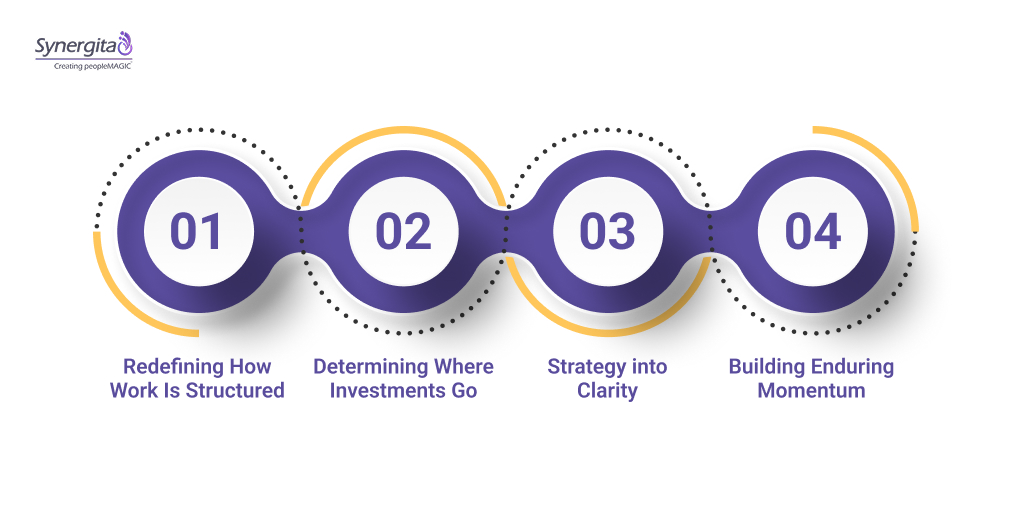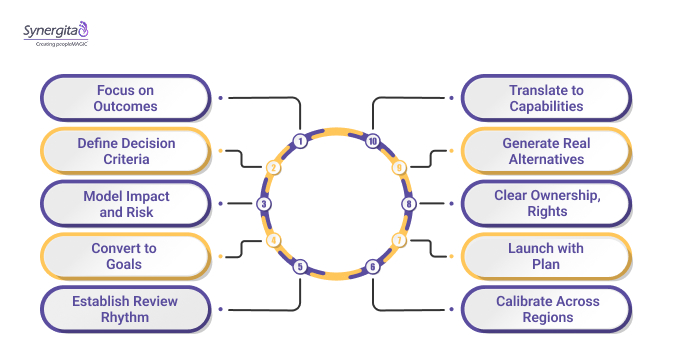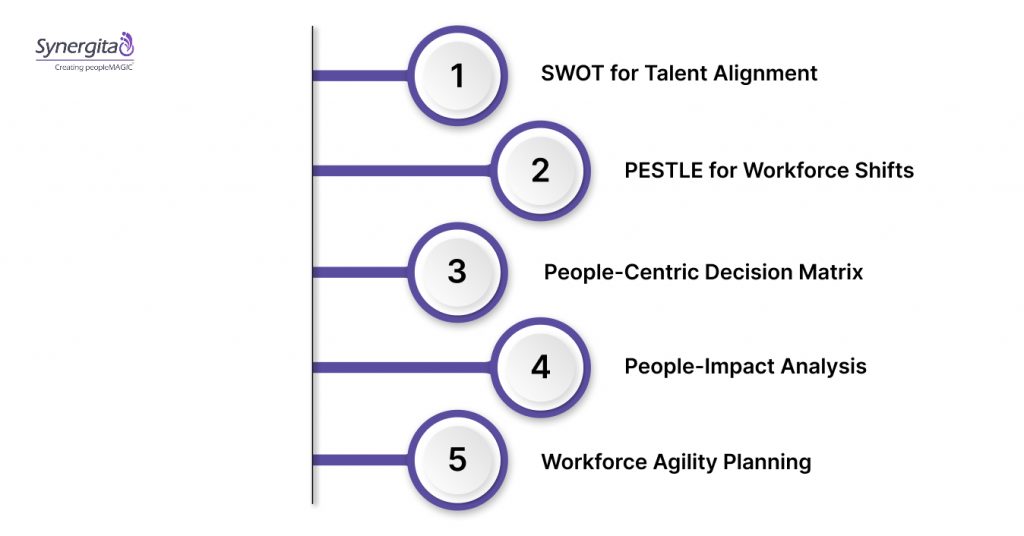Take a moment to consider your team. They log in on time, complete their tasks, attend meetings, and fulfill their responsibilities. On paper, everything seems fine. However, if you’ve ever felt that a spark of motivation is lacking, you’re not alone in that observation.
According to Gallup, only 23 percent of employees worldwide feel engaged in their work, leaving the majority disconnected from the goals and energy that drive real performance. That disengagement doesn’t just lower morale. It costs companies billions in lost productivity every year.
The truth is, motivation has little to do with one-off perks or annual bonuses. Real motivation takes root when employees see why their work matters, when they can track their progress clearly, and when they feel trusted to make decisions that influence outcomes. In this blog, we will explore how you can build that kind of environment and turn motivation into something that happens naturally every day.
Key Takeaways
- What Strategic Decision Making Is: A clear definition with examples that show how it differs from tactical and operational choices.
- Why It Matters for Growth: How strategic calls shape hiring, investments, and long-term competitiveness.
- Key Characteristics: The traits that make these decisions high-impact and hard to reverse.
- Step-by-Step Process: A practical framework leaders can use to turn strategy into execution.
- Useful Frameworks and Tools: How SWOT, PESTLE, and scenario planning help leaders make stronger choices.
- Common Challenges: Barriers like unclear vision, cultural resistance, and decision biases explained.
- Ways to Improve: Actionable practices that connect strategy with daily performance.

What is Strategic Decision Making?
Strategic decision making is about more than just selecting markets or chasing revenue targets. It is the process of setting a direction that defines how the organization grows, competes, and develops its people over time. These choices carry weight because they shape not only business outcomes but also how employees work and how performance is managed across the company.
- Strategic decisions commit the organization to a long-term path. Expanding into a new region, moving into an emerging industry, or shifting to a digital-first model are examples of choices that redefine talent needs and cultural priorities.
- Tactical decisions break down those choices into practical moves. A new market entry might translate into a focused hiring campaign, leadership training programs, or customer outreach strategies that support the broader direction.
- Operational decisions ensure that execution happens smoothly daily. These include scheduling, workflow adjustments, or responding to customer service issues.
Consider a company deciding to pivot into renewable energy. At the strategic level, this defines the type of skills to build, the markets to prioritize, and the investments to make. Tactically, it requires targeted recruitment and capability building. Operationally, it influences project staffing, resource allocation, and daily task management.
The important point is that strategy only works when it reaches employees in a way they can act on. People need to see how their goals connect to the bigger picture, receive timely feedback on progress, and feel accountable for results. Without this alignment, even the best strategic decisions risk staying stuck at the leadership level instead of becoming part of everyday work.
Why is Strategic Decision Making Important?

For HR and performance leaders, strategic decisions aren’t abstract concepts. They dictate how talent is managed, how performance is measured, and how the organization adapts to market realities. Operational adjustments can patch issues in the short term, but strategic calls define the environment in which everyday work either accelerates progress or gets stuck in cycles of inefficiency.
1. Redefining How Work Is Structured
When leadership decides to enter a new geography, spin up a business unit, or withdraw from a declining market, the impact is immediate. It changes hiring priorities, redefines role expectations, and shifts what success looks like at every level. HR leaders must translate those moves into aligned goals and capabilities, ensuring employees are prepared for the new direction.
2. Determining Where Investments Go
Strategic decisions commit budgets, technology, and talent at scale. Choosing to double down on digital transformation, for instance, not only requires capital but also reshaping performance frameworks, re-skilling programs, and career paths. These commitments are rarely reversible, which is why poor alignment between strategy and people practices can lock the organization into years of stalled growth.
3. Turning Strategy Into Everyday Clarity
Employees do their best work when they understand the “why” behind their goals. A well-communicated strategic decision gives people a clear line of sight from their daily tasks to organizational priorities. Without this, teams may put in effort that looks productive on the surface but doesn’t move the company closer to its long-term vision.
4. Building Enduring Momentum
The effectiveness of strategic decision making isn’t proven in quarterly results; it’s reflected in whether the organization sustains progress year after year. For HR and performance leaders, the challenge is to hardwire those choices into performance systems, feedback loops, and recognition practices. That’s what turns high-level strategy into measurable outcomes that people can see and feel in their work.
How to Make Strategic Decisions (Step by Step)

This process is built for leaders who need a strategy to show up in people plans, performance goals, and day‑to‑day execution. Each step avoids theory and focuses on what HR and business owners actually do next.
1. Frame the decision in outcomes, not activities
State the strategic question and the business outcomes that prove success. Define the decision scope, the time horizon, and the non‑negotiables. Examples of outcome measures to fix up front include revenue mix by region, margin targets, customer retention, time‑to-market, and risk tolerance.
2. Translate the choice into people and capability requirements
List the roles, skills, leadership capacity, and headcount ramp the decision will require. Map current capability versus required capability to expose gaps. Useful metrics include time‑to‑capability for critical roles, internal mobility potential, and vendor or partner capacity where you plan to outsource.
3. Set explicit decision criteria and constraints
Agree on the filters before evaluating options so you do not move the goalposts later. Typical criteria include financial return, execution complexity, talent availability, compliance exposure, and impact on customer experience. Document thresholds such as minimum ROI, maximum burn, acceptable payback period, and allowable increase in regrettable attrition.
4. Generate real alternatives, not variants of the same plan
Create at least three materially different paths. For example, build in‑house, partner or acquire; one‑region pilot versus multi‑region rollout; product‑led growth versus enterprise motion. For each alternative, assemble a high‑level resourcing model, timeline, and capability plan so comparisons are apples to apples.
5. Model impact and risk with leading indicators
Go beyond NPV. Add people and execution signals you can see early. Track hiring velocity for critical roles, enablement completion rates, first‑90‑day productivity, and customer adoption milestones. Run simple scenarios for best case, base case, and constrained case to test resilience under talent shortages or budget caps.
6. Decide with clear ownership and decision rights
Name the accountable owner, the approvers, and those who must be consulted. Record the rationale, chosen option, and what evidence would trigger a course correction. Use one‑way versus two‑way door logic. If the move is hard to reverse, raise the evidence bar and build a pre‑mortem on how it could fail.
7. Convert the decision into goals, measures, and ownership
Cascade the choice into concrete objectives for functions and teams. Tie every objective to a measurable key result and a single owner. Examples include quota capacity added per quarter, customer go‑live count, time‑to-first‑value, capability uplift for priority skills, and leadership span health.
8. Launch with a change plan people can actually follow
Publish what is changing, why it matters, and how success will be measured. Provide role‑based enablement for managers and individual contributors. Remove friction up front by adjusting incentives, updating job expectations, and retiring conflicting KPIs that would pull teams off course.
9. Establish a review rhythm that favors early course correction
Hold short, recurring reviews at weekly or biweekly cadence on leading indicators, with monthly deeper dives on outcomes. When signals drift, change inputs fast: reallocate headcount, sharpen the customer segment, or pause non‑critical work rather than waiting for quarter end.
10. Calibrate and learn across regions and functions
Run cross‑functional calibration sessions to compare results, surface bottlenecks, and standardize what works. Capture lessons learned in a decision log so the next strategic call starts smarter, with better assumptions and clearer talent requirements.
This sequence turns a leadership choice into aligned goals, visible progress, and faster adjustments. It keeps strategy from living in a slide deck and moves it into hiring plans, capability building, and the weekly work your managers guide.
Proven Frameworks and Tools for Strategic Decision Making

HR and business leaders do not need frameworks for the sake of analysis. They need tools that help translate strategy into workforce decisions, capability building, and performance alignment. Here are some that matter in practice:
SWOT Analysis for Talent and Capability Alignment
A classic tool, but when applied through a people-first lens, it becomes powerful. Instead of limiting SWOT to market opportunities, use it to assess:
- Strengths: current leadership bench strength, core skills, or strong engagement pockets.
- Weaknesses: capability gaps, low-performing units, or high turnover risks.
- Opportunities: emerging skills in the market, internal mobility, or untapped cross-functional collaboration.
- Threats: attrition of high performers, cultural misalignment during change, or competitors attracting your talent.
PESTLE Analysis to Anticipate Workforce Shifts
External forces always shape talent strategy. PESTLE goes beyond compliance or market trends. For HR leaders, it helps uncover:
- Political: new labor laws or regional workforce restrictions.
- Economic: inflation or wage pressures that impact retention.
- Social: employee expectations for hybrid work or well-being.
- Technological: automation or AI altering job roles.
- Legal: changing employment contracts, data privacy in performance tracking.
- Environmental: sustainability pressures are reshaping skill needs.
Decision Matrix for People-Centric Trade-offs
When leaders face competing options, a weighted decision matrix helps prevent bias. For example, deciding between in-house leadership development vs. external programs. Criteria might include scalability, speed of impact, cultural alignment, and long-term ROI on employee performance.
Cost-Benefit Analysis Grounded in People Impact
Traditional financial models overlook the organizational cost of disengagement and poor performance. A cost-benefit analysis that includes employee retention, productivity, and learning agility paints a more accurate picture. For example, investing in a modern performance management system may carry upfront expense but prevents years of inefficiency caused by fragmented reviews and inconsistent goal alignment.
Scenario Planning for Workforce Agility
No strategy survives unchanged. Scenario planning helps leaders imagine “what if” cases:
- What if a new geography requires 500 new hires in 12 months?
- What if digital transformation halves the need for certain roles?
- What if high-potential talent leaves faster than anticipated?
Running people-focused scenarios ensures strategy is executable in real-world conditions.
Common Mistakes in Strategic Decision Making
Even with the right frameworks, organizations stumble when decisions don’t translate into aligned performance. Here are some of the most frequent pitfalls for HR and business leaders:
1. Lack of Clarity or Vision
If strategy is not articulated in terms that employees understand, it becomes noise. Vague directions like “drive innovation” or “improve customer focus” don’t help managers set goals or employees prioritize daily work. The challenge is converting ambition into measurable goals that cascade through performance systems.
2. Cultural Resistance to Change
People’s practices often lag behind strategic ambition. A company may decide to pivot to digital-first, but if managers still evaluate employees using outdated measures of presence instead of output, resistance builds. Without embedding a strategy into performance management, culture pulls against change.
3. Data Silos and Poor Information Flow
Strategic choices rely on seeing the full talent picture: skills, performance, engagement, and attrition risk. When data lives in silos across HR, finance, and business systems, leaders end up making decisions blindly. This undermines both the quality of the choice and the credibility of leadership communication.
4. Biases and Shortcuts in Leadership Teams
Strategic decisions are rarely purely rational. Confirmation bias leads executives to overvalue familiar markets. Groupthink silences dissenting views about talent risks. Availability bias pushes leaders to chase the latest trend without testing internal readiness. HR leaders can counteract this by bringing evidence from performance analytics and workforce data into the decision room.
How to Improve Strategic Decision Making?
Improving strategic decision-making is not about adding more layers of analysis. It is about ensuring leaders have clarity, employees see how their work connects to strategy, and the organization adapts quickly when conditions change.
1. Set SMART Goals That Cascade Across the Organization
Clear goals prevent wasted effort. Specific, measurable, achievable, relevant, and time-bound objectives help translate corporate priorities into team deliverables. For example, a company goal to improve retention becomes a customer success target on renewal rates and an HR goal on manager coaching effectiveness. Tools like Synergita make cascading seamless so alignment does not get lost between levels.

2. Involve Diverse Perspectives in Decision Making
Strategic calls are stronger when they reflect the realities of different functions. HR leaders bring insight into talent supply, finance leaders highlight budget constraints, and operations leaders understand execution risks. Synergita supports this inclusivity by surfacing performance and engagement data from across departments, giving leaders a more complete picture before decisions are finalized.
3. Create Feedback Loops That Drive Adaptation
Decisions need constant testing. Quarterly or annual reviews leave too much lag between issues and adjustments. Regular check-ins and structured feedback create the agility to adapt in real time. Synergita’s continuous feedback system embeds this rhythm, so performance conversations are not delayed until year-end.
4. Use Technology for Real-Time Insights
Strategic decisions fail when they are made with outdated information. Leaders need real-time insights into progress, risks, and resource constraints. With Synergita’s analytics dashboards, organizations can see how decisions impact performance as they unfold, not after the fact.
5. Build a Culture of Adaptability and Learning
Resilience comes from giving people the tools and support to adapt. When employees can see their growth paths and connect them to strategy, they feel equipped to meet shifting demands. Synergita enables this by linking performance goals with development opportunities, ensuring that decisions turn into long-term capability.
If you want to see how these practices can work in your organization, start your free trial of Synergita today and experience how strategic clarity turns into everyday execution.
Conclusion
Strategic decisions are only as powerful as the people and systems that bring them to life. Leaders may choose the direction, but without alignment in goals, feedback, and performance, even the smartest strategy risks stalling.
Synergita helps close that execution gap. By connecting strategy to daily work, it ensures decisions don’t remain on slides but turn into measurable outcomes. If you are ready to see how this works in practice, book a demo with Synergita today.
FAQs
Q: What is meant by strategic decision?
A: A strategic decision is a long-term choice that sets the direction of the organization. For HR and business leaders, this means aligning workforce planning, performance systems, and culture with the broader goals set by leadership.
Q: What is an example of a strategic decision?
A: A company deciding to expand into a new market is a clear example. For HR leaders, this translates into building local teams, adjusting performance goals, and preparing employees to succeed in a new environment.
Q: What are the 5 key characteristics of a strategic decision?
A: Strategic decisions involve major commitments of people and resources, create long-term impact, carry risk, and cut across multiple functions. For HR, the critical characteristic is adaptability, since workforce priorities must evolve as business conditions change.
Q: Why are strategic decisions important?
A: They matter because they shape not only revenue and market share but also how employees experience their work. Strategic decisions provide the clarity employees need to align goals, stay motivated, and perform at their best.
Q: How to make a strategic decision?
A: Effective strategic decisions require more than just financial modeling. Leaders need clear outcomes, diverse perspectives, and real-time insights into talent, engagement, and capability gaps. Including HR data in the decision-making process makes execution far more effective.
Q: Who is responsible for planning and making strategic decisions?
A: While CEOs and boards set direction, execution depends heavily on HR, finance, and operations leaders. HR plays a critical role in ensuring that people strategies, performance systems, and capability building match the chosen direction.


